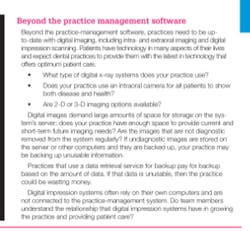Is your software as healthy as your dental practice? Various factors affect software effectiveness
By Ann-Marie DePalma, RDH, MEd, FADIA, FAADH
As hygienists, we are on the cutting edge of maintaining our patients’ oral and physical health. We review comprehensive medical histories, record periodontal findings, and perform oral cancer screenings. But do you know the “health” of your dental practice?
As dentistry and dental hygiene have been transformed by technology and the business of dentistry has become more important, hygienists should be aware of the health of the practice in which they are employed. I am not necessarily suggesting that hygienists know all of the practice metrics, such as accounts receivable, but there is some basic information beyond the clinical operatory about which hygienists - in fact, all team members - should be aware. Most of this information can be obtained within the office’s practice-management software, while other pieces of the puzzle come from discussions with the team.
Do you know whether your practice is currently using the latest version of your practice-management software?
Recent advances in updating dental software programs allow for quicker turnaround for developers to enhance programs or fix glitches or bugs within the program.
Do you know whether your practice performs a verified backup every day?
Technology is great when it works, but it can be a nightmare when it doesn’t. Verification is the testing of the backup to ensure that it is valid. If a computer system crashes and the server (the data storage computer) needs replacement, can the previously stored information be easily obtained? How often is it verified - once a day, once a month, once a quarter, once a year, or never? Is the backup done on-site, away from the office, or is it cloud-based? Is it encrypted? Business team members and lead clinical team members should understand the systems that the practice has in place so they can make sure the technology works properly.
Does your practice have a disaster recovery program?
How will the practice function if your computer system is down? Similar to practicing emergency protocols, the entire team should be on board with any protocols in the event of technology issues or system failures.
Many practices do not have a dedicated technology information person, while others employ outside vendors or have only one team member who understands technology as the official IT person. Does this IT person understand the intricacies of dealing with dental technology, both the hardware and software? Many companies provide specialized IT services for dental practices.
Is your practice using the most current CDT (Current Dental Terminology) codes?
As hygienists, we may not understand the complexities of the coding world, but with the Affordable Care Act comes the growing understanding of the oral-systemic connection and the role insurance plays in our day-to-day lives. Consequently, we need to have a basic understanding of how we bill our services. Currently, dentistry relies on the treatment-based coding system, but in the not-so-distant future, diagnosis coding will be more common. Our colleagues in medicine use diagnosis coding for all treatments.
Every year, the American Dental Association (ADA) releases the CDT for the current year, which updates new codes, deletes old codes, and revises descriptions. Is your practice aware of the most current codes and how to update these in your practice-management program?
Does your current practice-management software maintain an accurate recare system?
It is estimated that 40%-60% of restorative care comes from the hygiene operatory. If your recare system isn’t as robust as it could be, patients may fall through the cracks. Then, not only does the hygiene schedule suffer, but the practice in general suffers too. Maintaining recare is vital to the viability of the practice.
Are the appropriate systems, processes, and technologies available to implement a chartless or paperless practice?
Dentistry is moving toward a chartless, paperless environment. Whether we will be truly paperless is up for debate, but the practice-management software should enable the practice to become seamless and chartless. What does the patient workflow look like in your practice, from initial phone call to the end of patient life with the practice? Is it seamless or haphazard? Do all team members understand the workflow in the real world and in the virtual world of the practice-management system? How are you communicating with patients to engage them, whether by confirming appointments or marketing the practice? A number of companies offer patient engagement for dental practices similar to IT areas.
As we care for our patients by determining their needs and obtaining clinical data, we need to obtain that data and evaluate our practice based on technology. Assisting the practice to achieve optimum technology needs is a new avenue for hygienists. Beyond our traditional patient treatment skills and education, hygienists can play a critical role in growing the technology practice of 2017 and beyond.
For more information regarding the metrics mentioned in this article, please contact the author. RDH
ANN-MARIE C. DEPALMA, RDH, MEd, FADIA, FAADH, is the 2017 recipient of the Esther M. Wilkins Distinguished Alumni Award of the Forsyth School for Dental Hygiene/Massachusetts College of Pharmacy. She is a Fellow of the American Academy of Dental Hygiene and the Association of Dental Implant Auxiliaries, as well as a continuous member of ADHA. She presents continuing education programs for dental team members on a variety of topics. Ann-Marie has authored chapters in several texts for dental hygiene. She can be reached at [email protected]
Author’s note: Ann-Marie is a technology advisor for Patterson Dental and did not receive any compensation from Patterson for this article.

